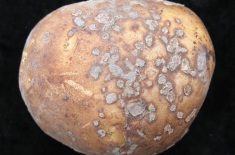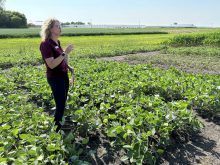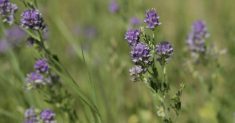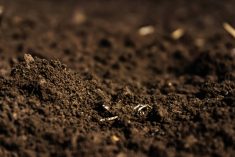SOUTHWEST
Rainfall accumulations ranged from 10 mm in the Melita area to 60 mm in the northern areas of the region.
Winter wheat harvest continued, as most producers were harvesting before the rain on the weekend. North of Highway 1, most producers have desiccated winter wheat but very little harvesting has been done. Yields to date are average with good quality. The majority of the fall rye crop has been harvested with yields slightly above average and good quality.
Barley harvest has started and yields are average. Most cereal crops are ready to be desiccated or swathed. Cereal crops in the northern part of the region are approximately two weeks away from desiccating.
Read Also

Manitoba sclerotinia picture mixed for 2025
Variations in weather and crop development in this year’s Manitoba canola fields make blanket sclerotinia outlooks hard to pin down
Canola crops are starting to turn. South of Highway 1, some crop is in the swath and a good majority will likely be cut this week. North of Highway 1, producers are about one to two weeks away from cutting. There have been no reports of any canola harvested to date.
Farmers have been harvesting peas with the majority of the acres done in the south. Most peas north of Highway 1 have been desiccated and will be harvested once the weather permits.
Sunflowers are flowering and corn is tasselling. Both crops require several weeks of warm, frost-free weather.
Second-cut hay is done and yields are below average with good quality. Areas that received rain over the past couple weeks have seen an improvement in pasture conditions.
NORTHWEST
Excess moisture in the Westlake area and in the Waterhen, Meadow Portage and Crane River regions has prevented most ranchers from accessing their native hay meadows. Good drying weather is needed to help with native hay harvest.
Reported tame hay yields are two-thirds to three-quarters of normal. Good tame hayfields that were cut early and had fertilizer applied are showing good second-cut regrowth.
Pre-harvest application of desiccants has taken place on a few advanced cereal fields. Fusarium head blight has been reported in some cereal crops. There is the odd canola field being swathed. Cereal and oi lseed crops require warm weather to advance to maturity.
CENTRAL
Rainfall accumulations in the region varied from 40 to 90 mm in eastern areas, while western parts of the region received 15 to 50 mm. Hail was reported in the Brunkild and Morden areas. Rain on Aug. 24 resulted in 10 to 20 mm of precipitation in a strip through Morden, Carman, Brunkild and Starbuck.
Winter wheat harvest is progressing with reports of yields ranging from 30 to 90 bushels per acre, with an average yield of 70 bu./ac. The Portage area reports sprouting, mildew, low fusarium and protein at 11 per cent. Pre-harvest applications continue in spring cereals. Swathing of barley has started and some combining has been done. Early reports have yields averaging 90 bu./ac. The oat and spring wheat harvest is just starting in western areas with no yield reports to date. Perennial forage crops are being swathed, with a small amount harvested.
Canola is maturing, with late-seeded canola still blooming. Some swathing has started. Blackleg and sclerotinia are being reported in some canola fields, causing lodging concerns.
Corn is in the grainfill stage with the exception of later-maturing hybrids or late-planted corn. Sunflowers are blooming. Soybeans are starting to form pods and flax fields are close to finishing flowering, with the earliest fields turning. White mould is reported in both edible beans and soybeans.
Haying continues with slow progress due to wet and humid conditions. Cool temperatures are slowing regrowth. Wet weather is keeping pastures green and growth adequate.
Potatoes are being irrigated as needed. Early table harvest has begun.
Grasshoppers are causing some concerns, but not widespread.
Uneven crop maturity will present some problems at harvest. Late-maturing crops and wet conditions are a concern for most producers.
EAST
The region received rainfall accumulations ranging from 15 to 44 mm last week and heat accumulation remained below normal. Weather conditions are delaying field operations.
Harvesting of winter wheat occurred last week. Fusariumdamaged kernels and sprouting are evident in harvested samples. Limited barley harvesting occurred, with reported yields of 80 to 90 bu./ac. The majority of the barley crop was ripe with swathing and combining proceeding where weather conditions allowed. Most of the wheat and oats were in the soft-dough stage with pre-harvest herbicide applications proceeding.
Swathing of canola fields occurred. Soybean development ranged from the R4 to R5 growth stages, with seed filling evident on some fields. Soybean aphid numbers nearing economic threshold levels were reported in some areas. Producers continue to monitor the situation. Flax continued pod filling. Sunflowers were at the R5.3 to R5.5 stage.
Hayfield conditions were rated as fair, with pasture land conditions rated as good. Limited progress was made in haying last week and wet weather has deter iorated second-cut hay remaining on the ground. Feed supplies remain a concern as a result of reduced first-and second-cut hay yields.
INTERLAKE
Rain throughout the week brought harvesting operations for hay, forage seed and winter wheat to a halt; however, harvesting resumed Sunday afternoon. Rainfall amounts through the week varied from 12 mm in the Ashern area to 70 mm in the Riverton/Arborg district.
Some winter wheat acres were straight combined at tough to damp moisture in the Stonewall and Warren areas. Yields range from 65 to 70 bu./ ac. with sprouting causing downgrading in some samples. Sclerotinia is showing up in many canola fields and white mould has been reported in soybeans. Fusar ium head blight has been reported in spring wheat. Crops require warm, dry weather conditions to advance to maturity.
Harvests of tall fescue and timothy forage seed crops continued Sunday afternoon. Hayfields lying in swaths were raked and baled and round bale silage was made on second-cut fields.
Feed and straw supplies are a concern for beef producers in the Arborg, Riverton, Gimli and Fraserwood areas as a result of excess moisture limiting haying operations and reduced annual cereal crop acres for straw.


















